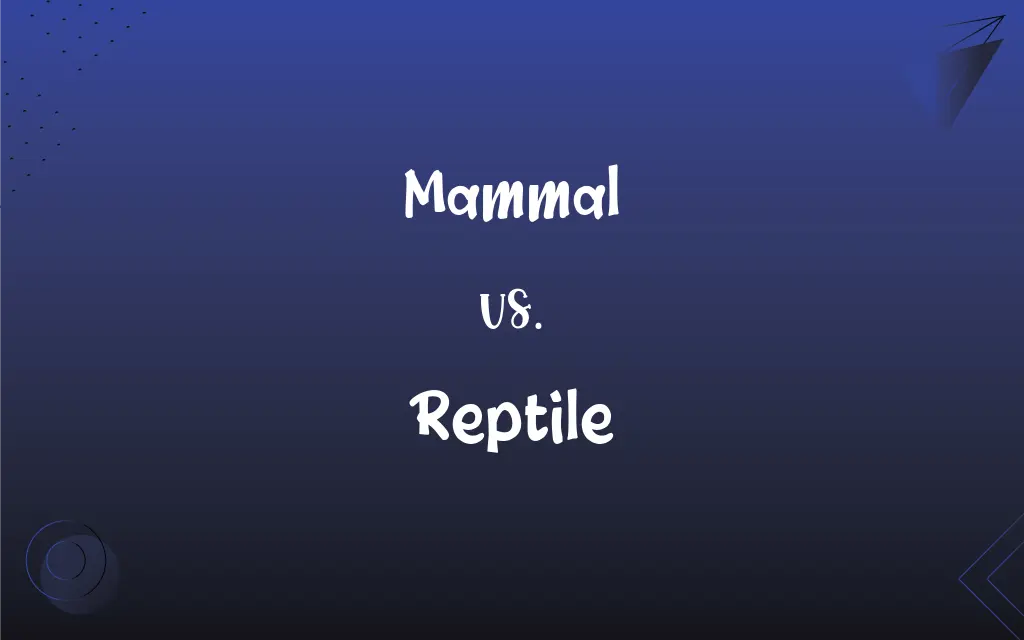Mammal vs. Reptile: What's the Difference?
Edited by Aimie Carlson || By Harlon Moss || Updated on October 27, 2023
Mammals are warm-blooded vertebrates with hair or fur, while reptiles are cold-blooded vertebrates with scales.

Key Differences
Mammals are warm-blooded creatures, meaning they maintain a constant internal body temperature, while reptiles are ectothermic, or cold-blooded, relying on their environment to regulate their body temperature.
Both mammals and reptiles belong to the vertebrate group, but mammals give birth to live young (with few exceptions), whereas most reptiles lay eggs.
Another distinguishing feature is the presence of mammary glands in mammals, which produce milk to nourish their young. Reptiles, on the other hand, do not have mammary glands and do not produce milk.
Mammals have hair or fur covering their bodies, providing insulation. Reptiles possess scales, which offer protection but do not provide thermal insulation as fur does.
The heart structure also differs: mammals typically have a four-chambered heart, ensuring a separation between oxygenated and deoxygenated blood. In contrast, most reptiles have a three-chambered heart, with some exceptions like crocodilians that have a four-chambered heart.
ADVERTISEMENT
Comparison Chart
Blood Type
Warm-blooded (endothermic)
Cold-blooded (ectothermic)
Reproduction
Gives birth to live young (mostly)
Lays eggs (mostly)
Body Covering
Hair or fur
Scales
Heart
Four-chambered heart
Three-chambered heart (some exceptions)
Feeding Young
Possess mammary glands and produce milk
Do not produce milk
ADVERTISEMENT
Mammal and Reptile Definitions
Mammal
Most mammals give birth to live young.
The dolphin, a mammal, gives birth to live calves.
Reptile
Reptiles do not have mammary glands and don't produce milk.
The crocodile, a reptile, leaves her eggs unattended.
Mammal
Mammals possess mammary glands to feed their offspring.
The cow, a mammal, provides milk for her calf.
Reptile
Many reptiles have a three-chambered heart.
The chameleon, a reptile, has a unique heart structure.
Mammal
Mammals are warm-blooded vertebrates.
The lion, a mammal, prowls the savanna.
Reptile
Reptiles have scales covering their bodies.
The snake, a reptile, sheds its scales periodically.
Mammal
Mammals typically have a four-chambered heart.
The human, also a mammal, has a complex cardiovascular system.
Reptile
Most reptiles lay eggs.
The turtle, being a reptile, buries its eggs in the sand.
Mammal
Mammals have hair or fur on their bodies.
The bear, being a mammal, has a thick fur coat.
Reptile
Reptiles are cold-blooded vertebrates.
The lizard, a reptile, basks in the sun to warm itself.
Mammal
Any of various warm-blooded vertebrate animals of the class Mammalia, including humans, characterized by a covering of hair on the skin and, in the female, milk-producing mammary glands for nourishing the young.
Reptile
Any of various usually cold-blooded egg-laying vertebrates often grouped in the class Reptilia, having dry skin covered with scales or horny plates and breathing by means of lungs, and including the snakes, lizards, crocodilians, and turtles. In some classification systems, birds are considered to be reptiles because they are descended from reptilian dinosaurs.
Mammal
An animal of the class Mammalia, characterized by being warm-blooded, having hair and producing milk with which to feed its young.
Mammal
(paleontology) A vertebrate with three bones in the inner ear and one in the jaw.
Mammal
One of the Mammalia.
Mammal
Any warm-blooded vertebrate having the skin more or less covered with hair; young are born alive except for the small subclass of monotremes and nourished with milk
FAQs
What is a reptile?
A reptile is a cold-blooded vertebrate with scales.
Do reptiles give birth to live young?
While most reptiles lay eggs, some, like certain snakes, give birth to live young.
What is a mammal?
A mammal is a warm-blooded vertebrate with hair or fur and mammary glands.
Do mammals lay eggs?
Most mammals give birth to live young, but a few, like the platypus, lay eggs.
Which mammal is known for laying eggs?
The platypus and echidna are unique mammals known for laying eggs.
Which is the largest mammal?
The blue whale is the largest mammal.
Why do mammals have fur or hair?
Mammals have fur or hair for insulation, protection, and sensory purposes.
What's the heart structure of reptiles?
Most reptiles have a three-chambered heart, but some, like crocodilians, have a four-chambered heart.
Do mammals have scales?
No, mammals have hair or fur, not scales.
Can reptiles be found in the sea?
Yes, some reptiles like sea turtles and marine iguanas live in the sea.
Are whales mammals or reptiles?
Whales are mammals.
Do reptiles feed their young with milk?
No, reptiles do not have mammary glands and don't produce milk.
What purpose do scales serve in reptiles?
Scales in reptiles provide protection and help in moisture retention.
Are snakes reptiles or mammals?
Snakes are reptiles.
Which is the largest reptile?
The saltwater crocodile is the largest reptile.
Do all reptiles have legs?
No, some reptiles like snakes and certain lizards do not have legs.
What do mammal offspring feed on?
Mammal offspring typically feed on milk produced by their mother's mammary glands.
Are all reptiles cold-blooded?
Yes, reptiles are cold-blooded or ectothermic, relying on their environment to regulate body temperature.
Do all mammals have a four-chambered heart?
Most mammals have a four-chambered heart which efficiently separates oxygenated and deoxygenated blood.
Are all mammals warm-blooded?
Yes, all mammals are warm-blooded or endothermic, meaning they maintain a constant body temperature.
About Author
Written by
Harlon MossHarlon is a seasoned quality moderator and accomplished content writer for Difference Wiki. An alumnus of the prestigious University of California, he earned his degree in Computer Science. Leveraging his academic background, Harlon brings a meticulous and informed perspective to his work, ensuring content accuracy and excellence.
Edited by
Aimie CarlsonAimie Carlson, holding a master's degree in English literature, is a fervent English language enthusiast. She lends her writing talents to Difference Wiki, a prominent website that specializes in comparisons, offering readers insightful analyses that both captivate and inform.































































